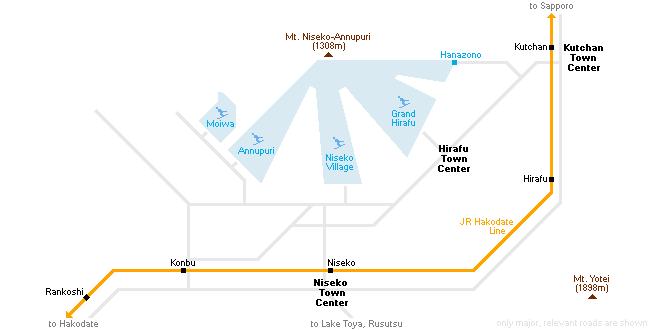
Focusing on winter activities, stretching my trip from Niseko in the West to Utoro in the East, distance travelled was undeniably long, but was an acceptable balance of travelling and exploring for me personally. And if you don’t mind long rides or changing accommodation every day, this itinerary might be for you to get the best out of Hokkaido.
Total Expenses (per pax)
*S$1 ≈ 80 yen
Attractions/ Activities: 33,000yen (incl. ski gear rental)
Accommodations: 18,521yen
Transport: 28,730yen
Food & Drinks: 26,026yen
Miscellaneous: 1,900yen (locker rentals & tips)
Total: 108,177 yen ≈ S$1352.21 + S$467.51 (flight incl. 20kg check-in luggage for the return leg)
= S$1,819.72
[Day 1 – Niseko (or Hirafu Town to be exact)]
My flight landed in Chitose Airport at around 4pm and Niseko is about 3hrs away. Clearing immigration was a swift especially since I didn’t had check-in luggage. There’s also a few changing rooms at the arrival hall for you to get properly dressed for the weather. Even if you are hopping onto the train immediately, do put on your jacket as it gets really cold at the train station. The JR train, including seats, is heated and you can take your jacket off inside.
By the time we arrived in Hirafu Town, having dinner was the only thing we could do before resting for skiing the next day.
Getting to Hirafu Town from New Chitose Airport
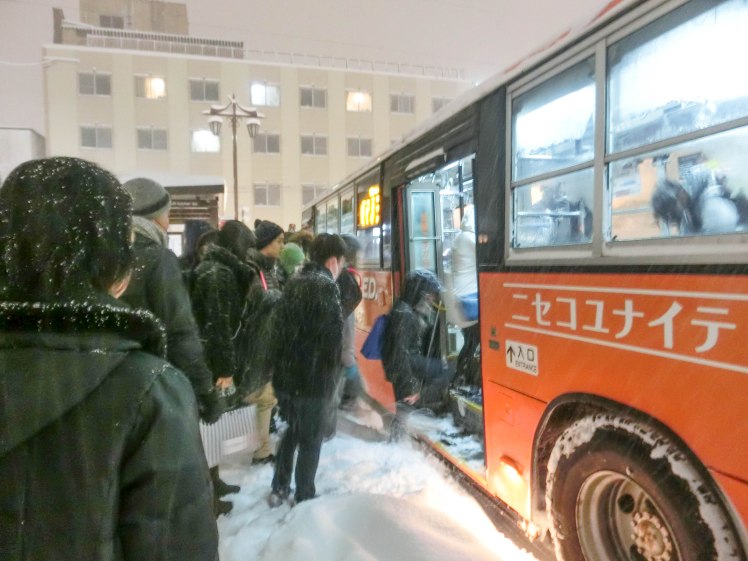
There are direct buses from the airport which can be cheaper and more convenient than trains. However, there is none after my arrival time, so JR train was the only choice (2630yen, around 3hrs. Will have to change at Otaru). HYPERDIA is a great website to check for train schedules and prices. It also tells which platform you arrive at and which platform you are departing from for connecting trains. Whether by bus or train, the trip will take around 2.5~3hrs. Change to a local bus (Donan or Hirafu bus. 390yen) upon arrival at Kutchan Station for Hirafu Town, which is approx. 15mins away (Yes, you are headed to the popular ski area Niseko. But if you are staying at Hirafu town, get off at Kutchan Station and not Niseko Station). We then alighted at Hirafu Welcome Centre and had one of the staffs there helped us inform our accommodation, who then arranged to have us pickup with their van. Arrange this with your choice of accommodation in advance if they provide pickup service.
Getting around Hirafu Town
Niseko United Shuttle
If you bought the All Mountain Pass (which gives you access to all Niseko’s ski resorts), Niseko United Shuttle will take you around Hirafu, Niseko and Annupuri during ski season for free. If you have a 12-point ticket, one point per trip is needed. Others need ¥500 for adult and ¥300 for child per ride. Base on 2017’s schedule, it seems that NUS does not travel to Kutchan Station before 5pm.
Hirafu Village Grand Shuttle Bus
Free shuttle bus around Hirafu town every 15mins, which brings you to Grand Hirafu Ski Resort as well.
Where to stay?
Hirafu town would be the most foreign-friendly with lots of bars, restaurants, accommodations, shuttle and local buses to get around (very important if you don’t have your own transportation), and plenty of food recommendations are based here. We stayed at Lodge Bamboo (4725yen per night for a bunk bed) which was very cosy, clean, served toast with jam or cereal for breakfast, and the shuttle bus to go around Hirafu stops at the foot of the lodge which is 1min walk away.
During my research way before the trip, I could still find dormitory for S$40+/- per night in a bunk bed, though these are normally outside of the town centre. As it gets closer to the trip, these were all occupied and it was hard to find budget accommodations for 2 travellers. Do book in advance or risk paying more. They could easily start from S$300 per night for a double at the cheapest.
What to eat?
We dined at Raku Izakaya on the first night – recommended for yakitori, buttery grilled Hokke fish, grilled king crab legs. 1 Big Hokke (1800 yen. Good for 3~4pax as a side. For 2 as a main), 1 grilled snow crab (1390 yen), 2 Hotategai (820 yen each), 1 pork skewer (460 yen. Best I’ve every eaten!) and 1 Kurabitosyu (800 yen. Hot Sake) cost us 6,577 yen (approx. S$82) in total.
Will come back again for the pork skewer, huge Hokke, and affordable sake.

Some other recommendations I found online are listed on Day 3. I can only say that dining in Niseko can be expensive. Consumption tax is 8%.
[Day 2 – Niseko]

Main activity for the day was skiing/ snowboarding. I booked an Adult First Timer Group lesson with GoSnow about 3 weeks in advance when I received a newsletter from them offering “bring a friend for free” program (13000yen = 6500yen/pax). This is a 5.5hrs lesson (incl. 1hr lunch break), which is for first timer as the program name suggest. It is possible to book one person on ski, and the other person on snowboard lesson if you wish. Overall, my experience with GoSnow was pleasant albeit my instructor was kinda slacking (he did mentioned that he is just working to save up for a ski trip elsewhere, which is equivalent to not teaching passionately).
The “bring a friend for free” program does not include gear and lift ticket however, which was required.

It was a first timer lesson though and we didn’t get to ride on the lifts at all the whole day, sliding down mild slopes and climbing back up. Same goes to the ski lesson, who spent most of their time on magic carpet. Thinking it was quite a waste especially since these tickets aren’t cheap, I went to the counter explaining that I was asked to get the lift pass for my snowboard lesson but the lesson did not required us to use the lift at all hence left unused, and they gladly refunded me.
For gear rentals, we got ours from Grand Hirafu (14200yen for 2 days full set rental; snowboard/ski set + skiwear + beanie + goggle + gloves). Though there were cheaper options, it required us to visit their stores for gear fitting a day before, which was not possible for us since we arrived rather late. Gear fitting will take about 30mins. Could be longer if the rental shop is extremely busy. Get there as early as you can. Rental lockers to store your clothes are from 400yen.
What to eat?
For lunch in-between ski lessons, there’s a cafe at the base of Grand Hirafu ski resort. If you are skiing down from the mountain, above holiday pair lift #1 lies an inexpensive lunch place called Boyoso. We tried none of these but the reviews online seems okay.
As for dinner, we went to try another recommended place, Niseko Ramen Kazahana for their potato foam spicy miso ramen (3.5 stars). We went almost immediately after they opened for dinner and it was already full when we got there. Since our lesson ended at 3:30pm, we went for tea break at Jojo’s Cafe & Bar while waiting for the restaurant to open – pretty good cakes and coffee (3.5 stars)

While doing research, I came across pictures of a cute little fridge door which turns out to be Bar Gyu (4 stars). We went for the sake of getting some pictures with the fridge door and a few drinks but surprisingly, it was really cosy with candles on our table, with large pane windows behind the bar where we watched the snow falls, awesome Charcuterie and cocktail served. The place is a bit cram. We waited around 15mins to get seats for both of us.

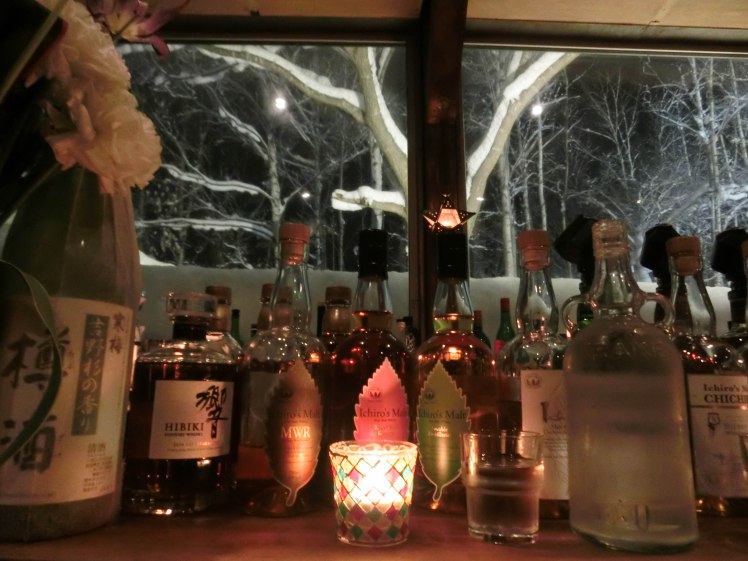

[Day 3 – Niseko]

Checked-out and placed our bags in the communal area while we went for another ski sesh. Being first timer and never had anyone guide me on how to get on the lift with my snowboard, I hesitated to get a lift pass for the day and instead, went sliding down the mild slopes and climbing back over & over again until I got so drained that we went back to our lodging for siesta.
For lunch, we headed to those food trucks near Hirafu grand shuttle bus stop #1. Turned out to be my favourite in Niseko among all other hypes is the sandwich at the aptly named Sandwichi & Deli truck. Do eat here especially if you are on a budget. There’s a selection of trucks for you to choose from and they serve delicious meals (not that I tried all, but the reviews online says so). One even served mulled wine at an affordable price, which is exceptionally great in the freezing cold.


Other food recommendation(s):
- Bang Bang – popular for its yakitori (2 locations)
- Abucha 2 – recommended for Suki-yaki. Their tofu tomato salad seems popular too.
- Niseko Supply Company – fresh croissants (which sells out fast), raclette and fondue set menus
- Yakitori Yosaku – beef skewers and cheese tomato
- Crab Dining Kanon – crab feast!
- Sessa Wagyu Hotpot – Sukiyaki or Shabu Shabu. Complimentary transfer for dinner available upon request.
Ps. Though I have tried some recommended restaurants – Raku Izakaya and Niseko Ramen Kazahana – if there’s only one thing I could eat again, it would be the sandwich from the food truck.
Torn between leaving Niseko without getting on the lift, or say the ski slopes actually, and getting on the beginner slopes without knowing how steep it would be, I couldn’t resist the temptation and got myself a night lift pass at 2700yen for usage after 4:30pm till the ski resort close. For the first ride, it is best to get someone who is riding solo to guide you if they are willing. After coming down the beginner slope for the first time, I could only say that I should have went up the slopes earlier as what I have done before this was nothing close to snowboarding.
But we were leaving for Otaru that night, so I ended up with only a short snowboarding sesh, which was still amazing anyway!
Recommendation(s):
If you would like to go skiing/snowboarding after 4:30pm and not do any of it in the day, Hirafu also offers hot springs or other winter activities such as snowmobiling.
[Day 4 – Otaru]
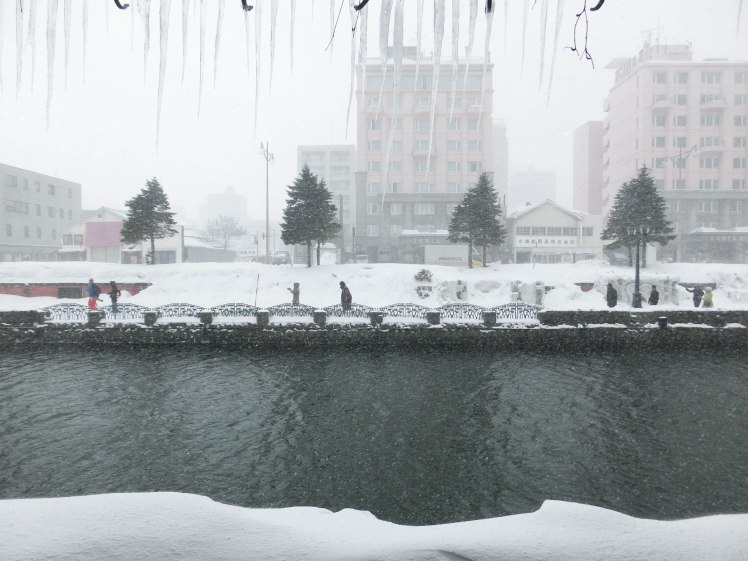
We just missed the Otaru Snow Light Path Festival (2018’s will be on February 9 to 18, 2018), but the strong gush of wind with the snow still made our trip there rather dreamy. Otaru was the coldest for us. Probably because it is close to the sea and the wind here can be really strong, it could even make our bone hurts.
Getting to Otaru from Hirafu Town
From Hirafu town, we took the bus back to Kutchan station (15mins, 360yen) and catch a direct train to Otaru (60~70mins, 1070yen)
What to do?

Otaru is known for its music box museum and glass works apart from Otaru Canal. The streets are such a bliss to walk in with music coming from gift shops. I recommend to start your day early and have at least a full day to explore, grabbing few beers at Otaru Beer Museum. We started exploring after breakfast at about 11am, and had enough time to visit music box museum, beer museum, otaru canal, the bank of Japan Otaru museum and few glass shops along Sakaimachi Dori. Other attractions are:
- Otaru Rail Museum
- Canal Building
- Museum of Venetian Art – this lies in Sakaimachi Dori where the music box museum, glass shops and bank of Japan museum is.
Where to stay?
Arriving late at night from Niseko, it really helped that our hotel is just 2 streets away from the train station. Smile Hotel Otaru has smoking & non-smoking rooms so do select the right one for you. Our room (4800 yen per night, double ensuite w/ breakfast) was small but clean enough, and the breakfast was a hearty meal. Do bear in mind that the double bed here is more like super single, similar to those in HK (if you know what I mean). So do look for a proper queen or king size bed if you are bigger in size. They provide luggage storage as well with tag for claiming it. The only con was the shower which took quite a while for the water to get heated.
The cheapest accommodation in Otaru I found was S$30 in a bunk bed, or S$60 for double ensuite. These may or may not include breakfast.
What to eat?
Right outside Otaru station, along Chuo Dori (dori means street), there are a few restaurants that stays open throughout the night and they are pretty affordable. We dined at 濱焼北海道魚萬 on the night we arrived. Nothing remarkable, but was at least not awful. Along Sakaimachi Dori are some seafood restaurants (looks like a small wet market with all the fresh seafood displayed at the storefront, with the dining area at the back) serving affordable crab hotpot, kaisendon and chirashi etc. Recommend to dine here as they are affordable and of great quality.


We didn’t get to try any of those listed below, but they received good reviews on the internet.
- Ajidokoro Takeda – affordable kaisendon
- Naruto chicken Otaru – heard that it is one of the must-try in Otaru
- Isezushi – sushi & sashimi. Slightly on the higher-end side.
- Yabuhan Soba – buckwheat noodles
- Sawasakisuisan Kaisenshokudo – kaisendon
- Kantaro – affordable and fresh sushi
- LeTao – there are few different stores in Otaru and each has its own concept. Items sold may vary. LeTao is famous for many things such as their double fromage cake, crepes, deu fromage roll, royal montagne, vanilla milk ice cream, cheese soft serve etc.
[Day 5 – Utoro]


Not many people come here as it can be a bit of a hassle to get to without a car. After a day in Otaru, we headed to Sapporo by train (40mins, 640yen) where a direct overnight bus to Utoro can be taken. We bought some snacks a.k.a. our dinner from the convenience store next to the bus station.
The nearest train station for Utoro is Shari station, 45mins away by car and there are no overnight trains to Shari so an entire day would be spent on travelling if via train.
Taking the overnight bus was quite a tough decision considering how slippery the road can be during the winter as ice could form and we are not even sure how the roads are like. The ride was really smooth, however, driving at slow steady speed, I slept throughout the night, waking up at Sunrise in Utoro. This is a coach with toilet, and they separate the male and female’s seat section. Single seats in rows of 3, reclinable chairs with footrest and slipper. Really comfortable.
The Eagle Liner leaves Sapporo at 11:15pm, arriving Utoro at 6:30am. 8230yen one-way or 15430yen return. Students can show their student pass and get it at 7200yen one-way or 13370yen return.
Upon arrival at Utoro Onsen Bus Terminal, we placed our backpack in one of the lockers for 500yen (3 different sizes. The largest one is 500yen; might not be able to fit anything bigger than a carry-on size limit. We fitted two 40L backpack into one. No time limit.). There’s also a toilet for you to wash up, though water was freezing cold.
Things were a bit rushed and I didn’t get to book a tour in advance. Wanted to join a guy on a tour he booked earlier but it was already full. So we walked around town and found this tour agency that offers Drift Ice Walking Tour + Snowshoe Tour at 9000yen per pax. If possible, do the drift ice walk during sunset tour as the scenery is amazing. The day looked gloomy for us, so it didn’t matter.
Sea of Okhotsk is the southernmost area in the Northern hemisphere where drift ice may be observed, and it is pretty cool to be walking on them. The drift ice has driven together, forming pack ice instead by the time we arrived in late February. We walked pretty far out into the sea (yes, the sea is just below) before we found a body of water which we dove into. Not exactly enjoyable, it requires a lot of strength at the waist. I found it easier by holding my leg against my chest.




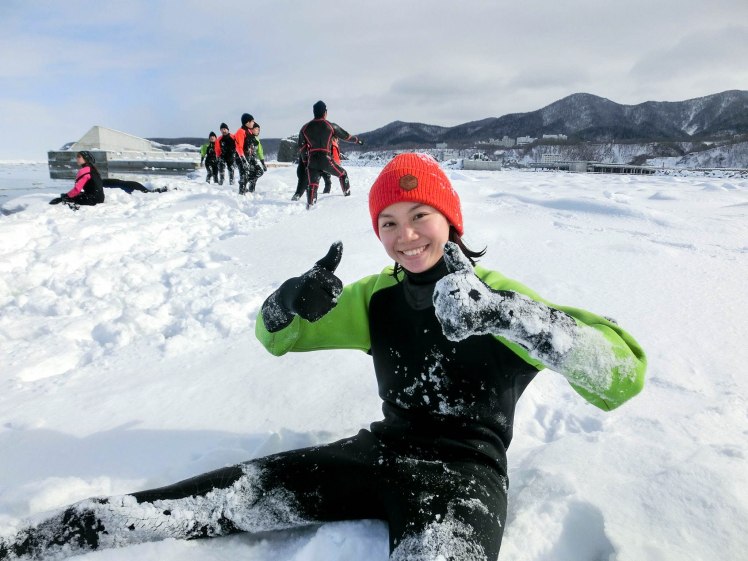
After the drift ice walking tour for part I, they dropped us off at this area with a few restaurants for lunch before another agency came to picked us up from across the street for part II of the tour – snowshoe walking. The tour guide spoke limited English, but was very patient and had a sense of humour. Few Japanese on the same tour spoke English and translated for us from time to time so we get to understand as well, having lots of laughter and fun in the snow throughout. At the end of the tour, they will drop you off at the bus terminal or your hotel while we chose to stop at their office (different from the one we booked this tour with) as we saw an onsen (hot springs) next to it earlier.







Couldn’t have made a better choice than to end the day bathing in rotenburo with snow capped mountain in sight. Since it was slightly out of the city centre, there were no other guests during our time there. The onsen has 2 showers (soap, shampoo and conditioner provided), a hairdryer, one indoor and one outdoor open-air bath, which was really nice. And this is just at the price of 600yen per pax with no time limit. Shiok!
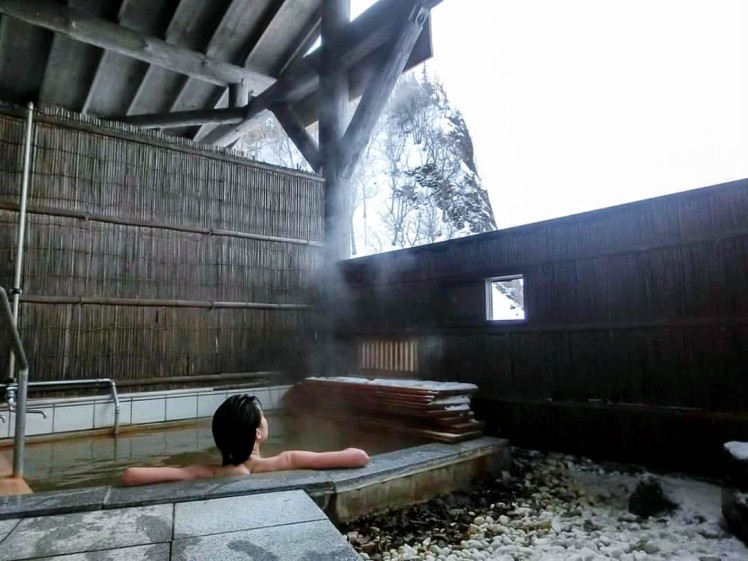
After a rejuvenating bath, we walked along the main road towards the bus stop, reaching town centre in about 15mins. There weren’t much traffic, and was really quiet but safe with street lamps along the way. As we passed by Bon’s Home, a cafe which is also a hostel, we got a potato cake (420yen) and potato curry rice (1080yen) from them as recommended online. The potato cake did not disappoint, and I would recommend it too. The potato curry rice whilst delicious, was a shocker with only plain rice, curry and few chunks of potatoes. Expensive considering I paid S$13.50 for this.


With this, we took the last Shari Bus at 6:30pm to Shari (1650yen one-way, 50mins. Schedule can also be found at Utoro Onsen Bus Terminal) and spent the night at Shari Central Hotel, conveniently located within 3mins walk from Shari JR Station. We booked a Japanese style triple room ensuite, sleeping on tatami for 8000yen. The staff will come up and lay the bed for you at your preferred timing, so do prepare tip (not obligatory). Clean and comfortable, the room also included a tea set which was lovely to have along our dinner. Breakfast is at 700yen per pax – do get the breakfast option especially if you are heading off early the next day. The breakfast they served was a delicious typical Japanese cuisine which includes few side dishes along rice and soup (3.5 stars).


[Day 6 – Lake Kussharo and Lake Mashu]
Lake Kussharo has a few rotenburo, which was my main experience for this trip. We decided on Kotan Onsen Rotenburo which is a free and open to public wild open-air hot springs, maintain weekly by local volunteers. It can be closed on tue, thu or fri for maintenance. I could not find an official website for it, but the bus which we took to the rotenburo has a notice that says it is closed on Friday when we went.
Getting to Lake Kussharo from Shari/ Utoro
We took the earliest train from Shari Station to Kawayuonsen Station at 7:26am (930yen, 50mins. Not possible if we had stayed at Utoro instead of Shari the night before), arriving at 8:19am before transferring to Kussharo Bus at 8:25am on the Teshikaga Eco Passport (1500yen for 2 days ticket. There’s no one day ticket). This is a hop-on-and-off bus that brings you around Lake Kussharo and Lake Mashu, and is the only bus that goes to Kotan Onsen. The bus also stops at Mt. Io and Sunayu for 20mins and 15mins respectively, just nice to get a glimpse and take some photos before we got off at Kotan Onsen at 9:32am.


Teshikaga Eco Passport provides free luggage storage at Kawayuonsen Station and Mashu Station from 8am as of now. When we went, the free luggage storage was only offered at Mashu station, so we had to carry our luggage with us. You can leave your baggage on the bus as you alight at Mt. Io and Sunaya for photo-taking. Needless to say, carry your valuables with you at all times.
*Do note that each season’s schedules are different. Check back when they release the schedule for the season you are visiting.
The facilities at Kotan Onsen includes a changing room (no shower), men and women separated, with shelves to place your belongings. There’s also a storage place outside the changing room, similar to those shoe racks in kindergarten, which you can spot from the onsen. So don’t worry about it getting stolen.



Men and women bath is in the same pool, seperated by a stone wall in between. Don’t be traumatised when they bath naked as it is custom in Japan. Throughout the experience, we were only joined by a local elderly couple. Highly recommend to experience at least one of these rotenburos around Hokkaido. The water temperature is just right. After soaking in it for some time, you can withstand the cold under the snow without clothes on, and dipping in again when feeling cold. Hot springs bath really does refreshes one mind & body.

Went into a restaurant, just next to Kotan Onsen along the road, while waiting for the bus to Mashu Station at 11:47am, stumbling upon one of the best ramen I’ve ever had (1200yen). It is a milk based ramen, only one on the menu. The owner stood by the door, looking out for our bus as they only served the dish 10mins before our bus is scheduled to arrive, and transport in Hokkaido was almost always on time. Though a bit rushed, do eat here if you have at least 40mins to spare (the wait was pretty long though there were no other diners). So good it was.
If not, have your lunch back at Mashu station where we dined at before catching the train to Obihiro after Lake Mashu. Next to Mashu Station lies a small restaurant which serves sliced pork rice (3 stars) recommended by staffs at the train station. We also tried Genghis Khan here (2.5 stars), which is a must try dish in Hokkaido. Might be better to try it at restaurants specialising in it.

Arriving at Mashu station at 12:10pm, we tried our luck at hitchhiking to Lake Akan as there were no public transport heading there from Mashu station after this timing. Only early morning departure. But luck was not on our side. With the eco passport we have already bought, we went to Lake Mashu instead, dubbed as the clearest lake in the world. We are not allowed to go down to the lake, only observable from the observation deck which the bus brought us to. The lake is often blanketed by fog in the winter, so count yourself lucky if you are able to see the body of the lake. You can place your luggage at Mashu station for free while you head to Lake Mashu.


The trip to Lake Mashu was pretty short, and we returned to Mashu Station by 3pm before travelling for the rest of the day to our next stop – Obihiro.
Getting to Obihiro from Lake Kussharo
From Mashu Station, we took the JR train to Kushiro Station departing at 5:23pm, arriving at 6:46pm (1640yen, 1h23mins) before changing to another train for Obihiro station at 7:26pm, arriving at 10:17pm (2490yen, 2h51mins). We bought our ticket all at once at Mashu station for 3990yen instead of 4130yen.
Alternative: There’s a faster train – Super Ozora Limited Express – for the Kushiro station to Obihiro station leg at 4810yen, taking 1h32mins reaching Obihiro at 8:32pm.
Where to stay in Obihiro?
Spent the night at Hotel Nupka (2200yen for a bunk bed in the dormitory). Comfortable bed, clean sleeping space and shared bathroom equipped with shampoo, soap, conditioner, hair dryer etc., and close to JR station. They stored our luggage the next day while we headed to Lake Shikaribetsu Kotan.
What to eat in Obihiro?
Arriving Obihiro late at night, we found a few izakayas around our hostel that were still opened (some till 3am). We settled at one (can’t remember which but was really affordable and delicious), having the appetizer each (mandatory), few fresh oysters (think half a dozen, a la carte), hot sake, 1 portion of pork belly, 1 beef patty with onsen egg and 1 charcoal grilled genghis khan for a total of 6182yen.


[Day 7 – Lake Shikaribetsu Kotan and Sapporo]
Lake Shikaribetsu Kotan is a winter village with igloos built on the lake when it freezes in winter. You can stay in the igloo houses with built-in ice bed, have a drink in the ice bar and listen to live-band at night, visit the ice chapel, experience ice sculpting or even soak in a hot spring in the open space. Unfortunately, for us, the weather was bad. Strong wind sent the snow flying in the air, slapping harshly on our face, and due to this, snowmobiles and hot springs were not operating. As we are not staying overnight at Lake Shikaribetsu and have to catch the bus back to Obihiro town at 1:10pm, we didn’t manage to get a drink at the bar too as they only starts serving in the evening.

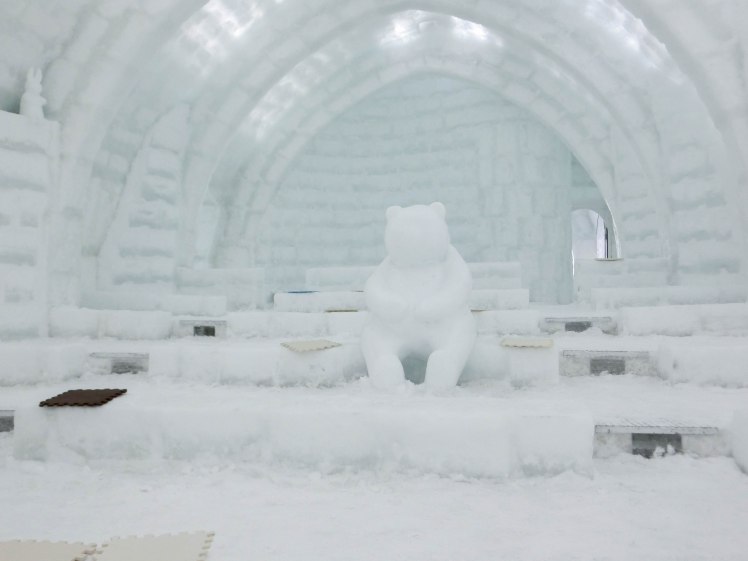
Getting to Lake Shikaribetsu Kotan
During the season, the festival provides free shuttle bus from Obihiro JR Station and Shintoku JR Station. Schedule can be found here. You can just hop onto the bus as usual at Obihiro JR station, but will need to obtain a return ticket from the desk at one of the 2 hotels located by the Kotan and pass it to the bus driver later when you board for the bus back.
What to eat at Lake Shikaribetsu?
At Cafe Mubanchi on the second floor of Lake Shikaribetsu Nature Center, where we seek refuge from the strong wind, are real awesome baked dishes. We had warm milk, hot chocolate and 2 baked dish for just 1800yen.


Getting to Sapporo from Obihiro
After Lake Shikaribetsu Kotan, we headed to Sapporo in the afternoon by JR train at 3:20pm, scheduled to arrive Sapporo at 5:56pm (6700yen, 2h36mins). Our train was late by about an hour for unknown reasons.
Alternative: Chuo Bus is cheaper at 3770yen but takes approx. 4hrs. Schedule can be found here (*may have changed).
Getting around Sapporo
Trams, trains, subway, buses are aplenty in Sapporo City. Many of the attractions are within walkable distance.
What to do in Sapporo?
For the night, we spent our time shopping at Tanukikoji Shopping Arcade where there are duty free shops, bars and karaokes.
Tip: Get all your souvenirs here especially if you are taking AirAsia which departs New Chitose Airport at 9+ in the morning while shops at the airport generally opens at 8:30am. Shiroi Koibito biscuits, Rokkatei’s frozen strawberry choco balls, royce potato chips, letao, Calbee’s potato farm, and beauty products etc. etc. can all be found here. Of course if you are getting items that needs to be kept chilled, it would be better to get at the airport if you have time.
*Do not open the bag once they have sealed it for you. If not, they will be subjected to tax.
What to eat in Sapporo/ Hokkaido?
Some of the recommended dishes or restaurants are:
- Genghis Khan – BBQ mutton. Sapporo Beer Garden and Daruma Honten is quite popular for it.
- Soup Curry
- Ramen Yokocho
- Sapporo Kani Honke – crab feast
- Wagyu
Where to stay in Sapporo?
We stayed at Mezamashi Sandwich for 2871yen in a bunk bed. Great location; close to Nijo market and Tanukikoji Shopping Arcade.
[Day 8 – Sapporo and Home]

As my flight is at 5:25pm, I had half the day to explore. Though not possible to visit each and every attraction, 3 to 4 near the centre should be fine as long as you start the day early. I managed to visit Nijo market for breakfast. Went into a random restaurant and had a mini portion of Uni & Toro kaisendon for 1900yen including miso soup. Though small, it was filling and the freshness of the seafood was excellent. I then headed to Sapporo Clock Tower, Sapporo Factory for shopping and Odori Park. Failed to find soup curry and ended up having personal Wagyu set lunch (1500yen) with Sapporo Beer (400yen) along Tanukikoji Shopping Arcade.

Other attractions:
- Sapporo Teine Ski Area – 35~50mins away from Sapporo Centre
- Shiroi Koibito Park – the factory for the popular Shiroi Koibito biscuits. You can make your own or see how the biscuits are made here.
- Curb Market
- Hokkaido University – great location for autumn foliage
- Hokkaido Shrine
- Mt. Moiwa – popular observation area especially at night when the city lights up
- Sapporo Community Dome – one of Sapporo’s snow festival site
- Historical Village of Hokkaido
- Historical Museum of Hokkaido
- Former Hokkaido Government Office
- Sapporo Beer Museum
- Susukino – Hokkaido’s largest entertainment district
- Sapporo Snow Festival – 2018’s will be held from February 6 to 12
Getting to New Chitose Airport from Sapporo City
JR trains depart almost every 15mins from JR Sapporo Station. One-way cost 1070yen and takes about 37mins. Alternatively, buses are also available though trains are recommended considering the weather and traffic.
